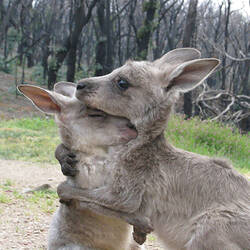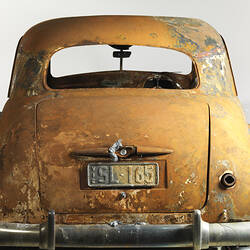Summary
Child's drawing with a message for the survivors of the Black Saturday bushfires.
In the days after Black Saturday in February 2009, in which 173 people died and thousands were injured or left homeless, people all over Victoria and Australia were moved to express their sympathy. Many of them directed messages of support to the emergency services, including the Burns Unit at The Alfred hospital.
Stonnington Primary is a state school in the suburb of Windsor in Melbourne's inner south. 155 children, from Prep to Grade 6, attend the school; they come from many different cultural backgrounds and speak 31 languages. Within days of the fires, the children decided to make gifts for patients at The Alfred hospital, which is not far from their school. The teacher wrote down messages that the children composed on a poster, and the children referred to this while making their pictures. Every child took part in the project; more than 100 gifts were produced and the older children then walked to the hospital to deliver them to the Burns Unit.
Physical Description
Drawing on white paper mounted on black card. Against a background of blue sky, yellow sun and a rainbow are the figures of a girl and boy between two green trees. Around them are flowers and a butterfly. The trees and the sky are decorated with glitter, sequins and beads. Attached to the bottom is a piece of yellow paper with a message in pencil, hearts and a drawing of a smiling house.
Significance
This picture was one of many gifts that were received by The Alfred hospital in the days following the bushfires of February 2009. People around the world responded to the crisis with donations of money and material aid but they also wanted to express personal messages of hope and support directly to the people involved. The Burns Unit, as one of the major hospital services receiving victims of the bushfires, was swamped with cards, letters and gifts not only for the patients but also for the staff of the Unit. This collection illustrates the power of the media in conveying the effects of the fires, but more importantly it demonstrates people's need to connect directly with the victims and their carers, regardless of whether they even know their names.
More Information
-
Collection Names
Victorian Bushfires Collection, Alfred Hospital Burns Unit Collection
-
Collecting Areas
-
Acquisition Information
Donation from Burns Unit, The Alfred Hospital, 2010
-
Sender
Stonnington Primary School, Windsor, Greater Melbourne, Victoria, Australia, Feb 2009
-
Recipient
Burns Unit, The Alfred Hospital, Melbourne, Victoria, Australia, Feb 2009
-
Place & Date Depicted
-
Inscriptions
Hand-lettered in pencil and crayon: Amelia / you are not alone . be strong. I will look after you as longe [sic] as I can. I will help you. at the / moment we are donating money to / you. / welcome to your new home / by Amelia Revers: 1/2P
-
Classification
-
Category
-
Discipline
-
Type of item
-
Overall Dimensions
425 mm (Width), 380 mm (Height)
-
Keywords



